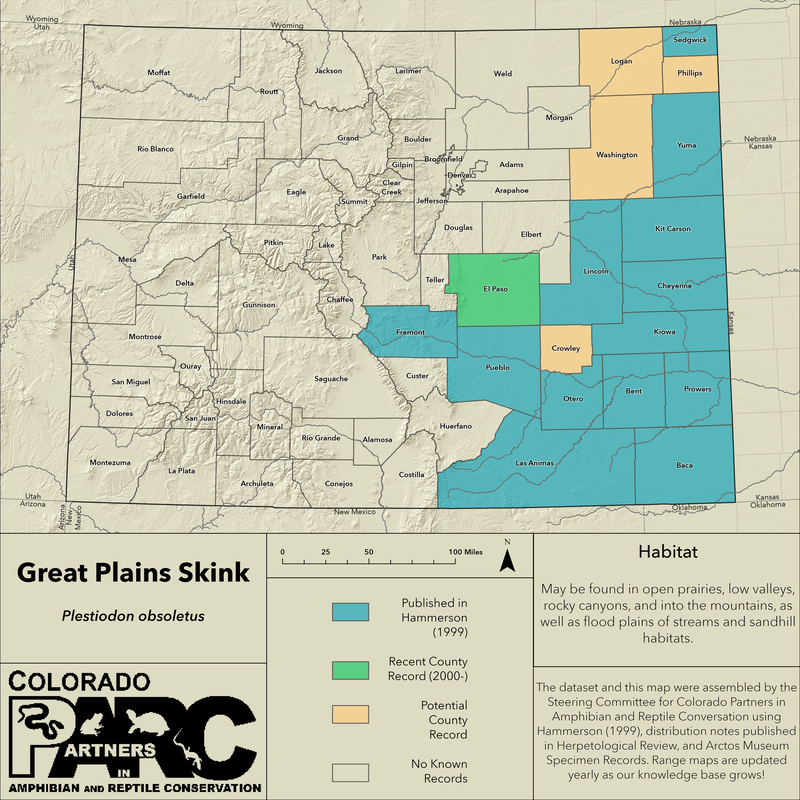Great Plains SkinkPlestiodon obsoletus
|
General Distribution: The Great Plains Skink is found from southwestern Iowa, eastern Missouri, and northwestern Arkansas through southern Nebraska, eastern Colorado, most of Kansas, Oklahoma, Texas, New Mexico, and west through central Arizona and south into Mexico. (Hammerson 1999; Caron & Swann 2009).
Colorado Distribution: Along the eastern margin of Colorado, with more extensive distribution in the southeastern portion of the state.
Colorado Distribution: Along the eastern margin of Colorado, with more extensive distribution in the southeastern portion of the state.
Conservation Status: Designated as a Non-game Species in Colorado. A Scientific Collection Permit from Colorado Parks & Wildlife is required to capture or handle this species (see State of Colorado regulations here). NatureServe rank: G5 (Globally Secure), S4 (State Secure). No major threats to this species have been identified, as they tolerate a moderate level of habitat alteration associated with agricultural use and cattle grazing. However, large-scale and intensive cultivation has reduced some populations.
Diagnostic Features
Coloration / Markings
- Smooth, cycloid, overlapping scales.
- Lacks bold body stripes.
- Dark crescent on the rear of dorsal scales forms an overall net-like pattern.
- Juveniles are solid black with a bright blue tail and white on the lips.
- Scales along the side of the body are in oblique rows.
Coloration / Markings
- Dark crescent on the rear of dorsal scales forms an overall net-like pattern.
- Body is grayish brown to tan to olive brown in color.
- Juveniles are solid black with a bright blue tail and white on the lips.
- Tail and limbs of the adults are yellowish to pale orange and lower portions of sides with faint orange spots.
- The belly is plain.
Size: Great Plains Skinks are not obviously sexually dimorphic, though males (especially the head) may be slightly larger than females. This is a large species, with adults reaching up to 5.6 inches (142 mm) snout-vent length (SVL) (Hammerson 1999; Caron & Swann 2009). Hatchlings are typically between 1.2 and 1.7 inches (33-43 mm) at hatching.
Habitat: May be found in open prairies, low valleys, rocky canyons, and into the mountains (Caron & Swann 2009), as well as flood plains of streams and sandhill habitats (Hammerson 1999).
Activity: The Great Plains Skink is primarily diurnal, and tends to be most active when the temperature is around 31-34 C (Caron & Swann 2009). This species may be active from May through September, with some activity possible in April and October if the temperatures permit it (Hammerson 1999). Rainfall is thought to potentially stimulate emergences from cover to drink and is associated with higher surface activity than when it is hot and dry. This species will struggle to be released if captured and will bite quite hard. The hibernation habits of this secretive species are not well known but they are expected to hibernate underground.
Reproduction: Both females and males reach sexual maturity at 3 years old (Hammerson 1999; Caron & Swann 2009). Courtship is initiated by the male, who may approach the female and attempt to touch her with his tongue, nip or nudge at the female and grasp her shoulders in his jaws (Hammerson 1999). Breeding occurs mainly in mid-May. Females skip at least one year between reproductive efforts and only lay one clutch per effort. Eggs are laid in June or early July. Clutch size can be from 7 to 24 eggs (Caron & Swann 2009), though Hammerson (1999) indicates that 8 to 15 eggs per clutch is more usual in Colorado. Females stay with their eggs for approximately seven weeks, through the incubation period and after hatching. Hatchlings start appearing around July or August (Hammerson 1999; Caron & Swann 2009).
Feeding & Diet: The Great Plains Skink eats insects such as grasshoppers, roaches, caterpillars, ants and beetles, as well as spiders, snails, and other lizards (Hammerson 1999; Caron & Swann 2009).
Defenses from Predation: The main defense of a Great Plains Skink from predation is their crypsis. However, like other species of skink, if caught by a predator, their tail is autotomous and can be willingly detached and will twitch as a distraction. Additionally, this species will bite and defecate if captured (Hammerson 1999; Sievert & Sievert 2011). Known predators of this species includes snakes, hawks, and carnivorous mammals (Hammerson 1999).
Cited & Additional Resources
Caron, M. D., and D. E. Swann. 2009. Great Plains Skink, pp. 456-459 in Lizards of the American Southwest. Lawrence L. C. Jones and Robert E. Lovich, eds. Rio Nuevo Publishers, Tucson, Arizona.
Hammerson, G. A. 1999. Amphibians and Reptiles in Colorado, 2nd Ed. University Press of Colorado & Colorado Division of Wildlife, Niwot, Colorado. 279-282 pp.
Sievert, G., and L. Sievert. 2011. A Field Guide to Oklahoma’s Amphibians and Reptiles, First Edition. Oklahoma Department of Conservation, The University of Oklahoma Printing Services, Oklahoma City, Oklahoma. 135 pp.
Hammerson, G. A. 1999. Amphibians and Reptiles in Colorado, 2nd Ed. University Press of Colorado & Colorado Division of Wildlife, Niwot, Colorado. 279-282 pp.
Sievert, G., and L. Sievert. 2011. A Field Guide to Oklahoma’s Amphibians and Reptiles, First Edition. Oklahoma Department of Conservation, The University of Oklahoma Printing Services, Oklahoma City, Oklahoma. 135 pp.
Account compiled by: Celina Bycenski
Reviewed by: Lauren Livo (text & map)
Last updated: 4/14/2022 by Rémi Pattyn
Reviewed by: Lauren Livo (text & map)
Last updated: 4/14/2022 by Rémi Pattyn
Suggested Citation
Colorado Partners in Amphibian and Reptile Conservation. 2014. Species account for Great Plains Skink (Plestiodon obsoletus). Compiled by Celina Bycenski. http://www.coparc.org/great-plains-skink.html [accessed date here]. Editor: Lauren Livo.
Colorado Partners in Amphibian and Reptile Conservation. 2014. Species account for Great Plains Skink (Plestiodon obsoletus). Compiled by Celina Bycenski. http://www.coparc.org/great-plains-skink.html [accessed date here]. Editor: Lauren Livo.


